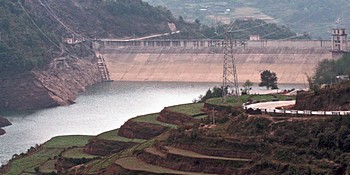Describing connections across policy domains is helpful, but the focus on water, energy and food is discretionary and limiting.

In recent years, many researchers and development practitioners have made it a priority to address the water-energy-food “nexus” – that is, the connections (and potential synergies or conflicts) involving water, energy and food.
Following a large conference in Bonn in 2011 that highlighted the nexus, the research-for-development community undertook a remarkably broad range of studies and consulting assignments purporting to take a nexus approach or to build and implement nexus tools. The nexus now appears across the natural resources literature, in much of the popular press, and in many of the calls for proposals put forth by international donors.
But does the water-energy-food nexus truly deserve such special status? Are there really such things as a nexus approach and nexus tools? In a recent paper, I address these questions, and I conclude that there are no such constructs.
Proponents of the nexus stress the need to consider links and interactions. Researchers and public officials must engage in an open, collaborative fashion and avoid working in silos. Food requires water, which can be used to generate energy, which is also used to produce food – a wonderfully neat and closed triangle for guiding research and policy intervention.
Yet recognizing links across natural resources or policy domains is hardly new. We have known about them for decades. Rachel Carson told us about interactions as early as 1962, in Silent Spring. Natural and social scientists around the world have discussed links and interactions at several historic UN conferences: on the human environment (in Stockholm, 1972), water (Mar del Plata, 1977), and on environment and development (Rio de Janeiro, 1992).
Might it be that many of today’s researchers and policy-makers simply were not around in those earlier years? Or did earlier notions regarding links and interactions fail to achieve the goals of enhancing research and policy analysis in practice?
To be fair, times have changed since the 1960s and 1970s. Today climate change is a serious concern, and the world seems smaller than ever. Ensuring food security and access to clean, safe water while sustaining energy resources seems more daunting than in earlier years.
The persistent increase in global population, rising incomes, and the growing divide between rich and poor have complicated the task considerably. Scholars speak of “tipping points” and “planetary boundaries” with increasing frequency and breadth. Could it be that the challenging outlook with regard to global resources has spurred the search for new and compelling notions to encourage greater awareness?
Creating awareness has its merits, yet conducting science and crafting policy are indeed very challenging endeavours. Both require notable rigour in theory and practice. They also require analysis of links and interactions that lie outside the cozy confines of the water-energy-food nexus.
Most observers would agree that water and energy are essential inputs in agriculture, but so too are labour, machines, chemicals and capital in most settings. Livelihoods in cities and the countryside are impacted by policies and investments regarding water, energy and food, yet livelihoods are not considered explicitly in most depictions of the nexus.
Given all these omissions, is it really possible to enhance understanding of food security, water scarcity, and smallholder welfare in developing countries using a nexus approach? The remarkable popularity of the water-energy-food nexus is not a sufficient substitute for conceptual legitimacy or analytical rigour.
Most observers would agree that these three essential inputs and outputs are linked, and that decisions regarding one component of the nexus can impact decisions and opportunities regarding other components. Interactions involving water, energy and food gain importance when scarcity intensifies. We see this often with regard to water, sometimes with land, and also with energy.
However, merely acknowledging interactions does not constitute a rigorous analytical framework. Indeed, most authors of nexus studies depict the relationships in their own, unique way. Lacking a robust, widely accepted conceptual framework, how can we know if one depiction is better than another, or if the nexus approach adds value to research and policy analysis?
Perhaps the nexus is a gimmick, rather than an analytical framework – an ingenious device designed to attract attention or increase appeal. The water-energy-food nexus certainly has proven to be appealing, particularly to those who have not yet studied evident links involving natural resources and the environment.
To consider the nexus a gimmick is not to be critical of its proponents. Rather, it is to suggest that perhaps we should recognize the nexus as a clever strategy to get the attention of some observers with an interest in agriculture, the environment and development – not an analytical framework.
Perhaps we could then agree, as well, to no longer speak of nexus tools or a nexus approach, as if such phrases were based on a valid conceptual foundation. Policy-makers and practitioners are counting on researchers to provide good science to inform their actions; putting the nexus in its rightful place would help us meet that expectation.
Design and development by Soapbox.